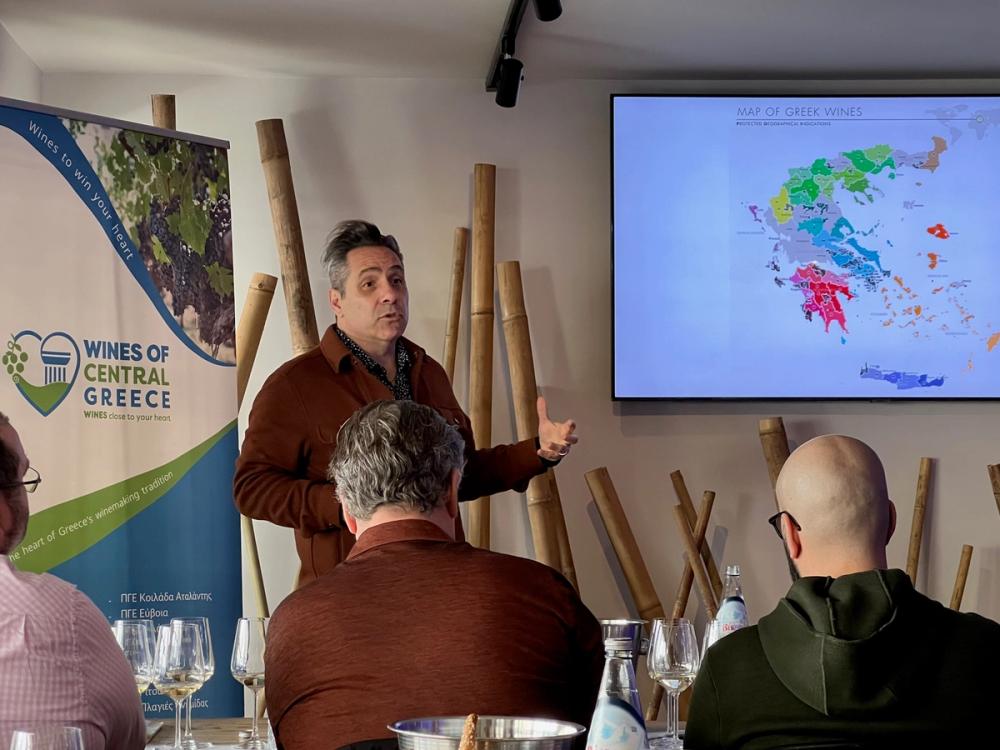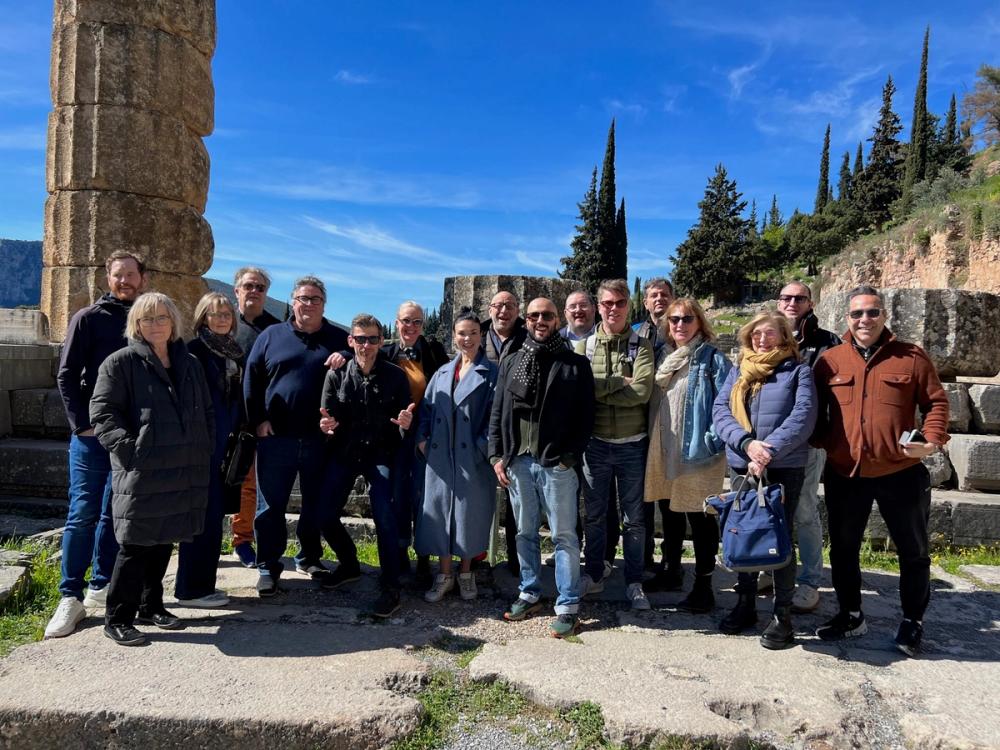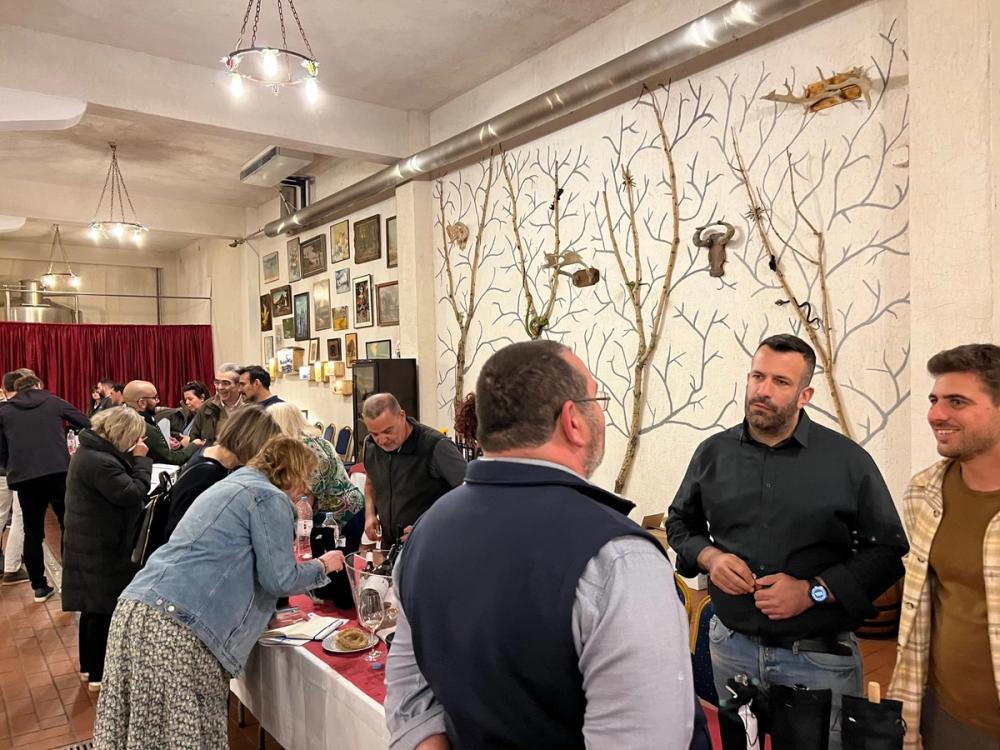Central Greece is the country’s largest wine region with 28% of its total vineyards, divided across nine distinct PGI areas each offering different styles of wine, many of which are yet to be widely distributed in the international wine market. Richard Siddle explains why it is ready to “come out from under the radar”. You can also taste a selection of Central Greek wines at this week’s London Wine Fair.
The typical visitor to Greece will fly into Athens and then quickly head out to one of its beautiful islands. But those in the wine trade would do well to hold off the lure of the likes of Santorini and Crete and instead head inland and up into its central areas where so much of the country’s wine is made.

Central Greece offers stunning views with its mountains, valleys and historical sites
An area that also remains off the main tourist map, despite its stunning beauty and mountainous landscape that provide a dramatic backdrop for many of the region’s vineyards that lie on their slopes, or down on the valley plains. In fact, if you were beamed Star Trek-style into the area you might be forgiven for thinking you were in a new undiscovered area of South Africa so imposing are the mountains that surround you – some over 2,000 metres high.
It is great to see how well the region’s indigenous varieties are doing and how proud its producers are to grow them. Central Greece is the homeland of two of the country’s white grape varieties: Savatiano and Malagousia – often used in a blend with Assyrtiko.
There is also a strong supporting cast of indigenous red grape varieties in the area most notably Mouchataro, Mavrokountoura and Vradiano. All of which have really come back into fashion in recent years as winemakers have been willing to test, trial and see which slopes and valleys are best suited to their unique qualities.

The imposing mountains are a key part of Central Greece’s landscape but also influence on the vines and its wines
In all there are over 40 indigenous and international varieties grown across Central Greece and it its proud to claim to be the “country’s laboratory of viticultural experimentation”.
The region certainly has enough vineyards to make an impression – 6,506 hectares to be exact. Of which they are made up of the following indigenous varieties:
- Savatiano: 3,955ha.
- Roditis (Retsina): 1,057
- Assyrtiko: 139ha
- Malagousia: 138ha.
Then on the international side there is:
- Cabernet Sauvignon: 2,735ha
- Syrah: 1,644ha
- Merlot: 145ha.
Diversity of styles
The diversity of grapes is matched by the number of sites where winemakers and producers are willing to see which terroirs suit which grape variety. All of which means the region is capable of producing white wines that are light, fresh and easy to drink, but also others that are more complex and savoury. The reds stretch from light, mellow styles to more sophisticated, terroir and tannin driven, stronger styles. It is also becoming a key area for rosé with most producers looking to have at least one rosé in their range – very much in keeping with its Mediterranean climate.

Yiannis Karakasis MW believes now is the time for Central Greece to “come out from under the radar”
All of which makes Yiannis Karakasis MW strongly believe the region now has all the pieces in place to “come out from under the radar” and is ready to help wine buyers and sommeliers discover the wines everyone in the area has been “working hard to produce”.
“All over Central Greece we have good quality producers making good quality, but also good value for money wines. We are now ready to export and that has to be our strategy going forward,” he says. “We can no longer just rely on the Greek domestic market for our sales.”
He adds: “The whole area of Central Greece is evolving. We are planting more vines including indigenous and international varieties, particularly Cabernet Sauvignon and even Cabernet Franc.”
With so many of its vineyards at higher than average altitudes – grown between 150m to above 600m – it is able to make the fresh, acidic styles of wine that are doing so well across all major international markets, including the UK, he adds. It also has a mild climate with average temperatures at around 18.4C and 370mm average rainfall.
This is best shown in the lighter, more mineral, higher acidity styles of Assyrtiko that are made in Central Greece compared to the richer, more salty, powerful styles associated with those coming out of Santorini. “In Central Greece they are more stone and tropical fruit, medium bodied and wines that retain their acidity,” says Karakasis. “It pairs with all types of food.”
Test and trial

The UK wine trade trip that visited Central Greece in the spring made up of importers, wine merchants, trade press and sommeliers
What’s exciting about the region is that producers and winemakers are still very much in the trial, test and experiment stage of their growth, he adds. “They want to discover for themselves. Try new ideas, use lees ageing more, try different formats,” says Karakasis.
The challenge and opportunity is to keep the traditions and know how associated with the indigenous varieties but to also embrace and look to discover more modern winemaking techniques. What can you be doing in the vineyards and cellar to make wines with more expression, more fruit characteristics of a particular grape variety?
There is also work being done to mitigate against climate change, particularly how producers area able to access water in what can be long months without any rainfall. To be able to continue to make grapes that can keep good acidity and are good for ageing.
Interestingly the Muses Estate, that is imported by Hallgarten & Novum Wines in the UK, thinks it is important for Greece to be able to show what it can do with classic varieties such as Cabernet Sauvignon and Chardonnay. It means producers are able to get into more international markets by offering what you might call their “safe” international varietal wines, “to show what we can do” and then offer their other indigenous based wines once they do well, says Stelios Zacharias, co-owner of Muses. “It depends on the market and what they want. If you take a mature market like the UK then it is looking for new things and wants to work with Greek varieties. But you need to have both.”
He adds: “The UK market is really important for us. UK consumers like Greek wines and it is seen as the next hidden treasure.”
“We feel like we are celebrating the Old World and New World at the same,” says Nikos Zacharias, winemaker at Muses Estate. “We have fruit that can work well in different ways. Be it skin contact, or low intervention winemaking. The key is to have good grapes to work with in the first place.”
Balanced climate

Panos Samartzis, owner and winemaker at Samartzis Estate, with Stelios and Nikos Zacharias, co-owners of the Muses Estate
Panos Samartzis, owner and winemaker at Samartzis Estate, says he is fortunate his winery and vineyards are so ideally placed being at the foot of the Helicon mountain and between two villages Askre and Vagia in the Muses Valley. An area that can be cold enough for snow in the winter, yet gets very hot in the long summer months. Vines that are between 450m to 600m to give a “lovely, fresh, acidity”.
“The last 10 years we have been changing and adapting how we make our wines,” he says. “The trend is very much towards a more modern approach, but that also keeps the character of the land. Wines that are more expressive of the single variety. Wines with less oak and more fruit.”
The area is blessed with large numbers of dry farmed old bush vines that sit alongside the newer plantings. Old vines that Karakasis says brings a “phenolic ripeness” to the wines and there is a lot of work being done in the region, but also across Greece to rescue, protect and nurture the old vines the country has. “The average vine in Central Greece is an old vine,” says Karakasis.
There is clearly also a strong spirit of collaboration and working together amongst the producers we met. Clearly proud of their own wines and the work they are doing on their own, but also very aware that this has to be a team effort if Central Greece is to reach its full potential.
“We are all in it together,” is how Samartzis puts it. “We have to protect and promote what we have.”
Introducing Central Greece’s PGIs

Old vines are a key feature of the styles of wine being made across Central Greece
Central Greece is divided into nine distinct areas – its PGIs. But whilst they each have their own distinct geographical characteristics and differences in soil types, climate and the grapes that are grown there it is more what the producers are doing in the vineyards and in their cellars that is the real story, stresses Karakasis.
The number of producers in each PGI also varies considerably. Here are the key attributes of each of the nine PGIs.
Atalanti Valley
Valley stretches from east to West. In the East lies the Parnassos Mountain (2.417m altitude) & in the west to the sea.
Vineyard altitude: From 30m.
Main grape varieties: White: Assyrtiko supported by Sauvignon Blanc, Chardonnay, Athiri, Verdiccio Bianco, Malagousia, Savatiano.
Pink: Roditis
Red: Cabernet Sauvignon. Other: Vradiano, Mavroudi, Cabernet Franc, Aglianico, Merlot, Limnio, Syrah, Carignan, Schioppettino, Refosco, Grenache Rouge.

The UK buyers had the chance to meet and taste a wide variety of wines from across all the PGIs in Central Greece during their recent trip
Knimida
Vines grown on southern slopes of Kallidromon Mountain (1,320m altitude).
Vineyard altitude: From 150m.
Main grape varieties:
White: Assyrtiko, Athiri, Savatiano, Kontokladi. Other: Sauvignon Blanc, Chardonnay, Athiri, Malagouzia, Ugni Blanc.
Pink: Roditis
Red: Vradiano, Limnio, Mavroudi, Cabernet Sauvignon. Other: Grenache Rouge, Syrah, Cabernet Franc, Merlot, Refosco, Limnio.
Opountia Locris
Vineyards surrounded by mountains and the sea to the east.
Vineyard altitude: 30m to 350m.
Main grape varieties: White; Athiri, Assyrtiko, Robola, Malagousia. Other: Sauvignon Blanc, Chardonnay, Ugni Blanc
Red: Limnio, Xinomavro, Cabernet, Sauvignon, Merlot. Other: Cabernet Franc, Syrah, Grenache Rouge, Syrah, Grenache Rouge.

The balanced climate allows winemakers to take advantage of hot summers and cold winters
Phthiotis
Vines grown on mountain slopes in semi continental climate.
Vineyard altitude: 350m to 550m
Main grape varieties: White: Aidani White, Athiri, Assyrtiko, Malagousia. Other: Aidani White, Athiri, Assyrtiko, Malagousia.
Pink: Roditis
Red: Vradiano, Mavroudia, Limnio, Aglianico. Other: Syrah, Grenache Rouge, Schioppettino, Merlot Cabernet Franc, Cabernet Sauvignon, Scioppettino.
Parnassos
One of Central Greece’s most mountainous vineyard areas.
Vineyard altitude: 350m to 550m.
Main grape varieties: White: Athiri, Assyrtiko, Malagousia, Robola. Other: Savatiano, Chardonnay, Sauvignon Blanc.
Pink: Roditis.
Red: Mavroudi, Cabernet Sauvignon, Merlot, Cabernet Franc. Other: Syrah, Pinot Noir.
Thiva
Cold winters, hot summers.
Vineyard altitude: 10m to 700m.
Main grape varieties: White: Athiri, Assyrtiko, Robola, Malagousia. Other: Sauvignon Blanc, Chardonnay, Ugni Blanc.
Pink: Moschofilero, Roditis.
Red: Mouchtaro, Agiorgitiko, Cabernet Sauvignon, Cabernet Franc. Other.: Carignan, Syrah, Merlot, Grenache Rouge.
Evia

The beautiful island of Evia is one of Central Greece’s emerging PGIs
Cooler in the north and arid in the south.
Main grape varieties: White: Savatiano, Assyrtiko, Malagousia, Aidani White. Other: Athiri, Monemvasia, Grenache Blanc, Sauvignon Blanc, Viognier, Muscat.
Pink: Moschofilero, Roditis.
Red: Mandilaria (Kountoura Black), Vradiano, Agiorgitiko, Liatiko. Other: Karabraimis, Syrah, Grenache Rouge, Merlot, Ritino, Cabernet Sauvignon.
Ritsona
Vines on hillside with sea breeze.
Main grape varieties: White: Savatiano, Malagousia, Assyrtiko, Monemvasia. Other: Sauvignon Blanc, Grenache Blanc, Aidani White, Athiri.
Pink: Moschofilero, Roditis.
Red: Vradiano, Agiorgitiko, Karabraimis, Mandilaria. Other: Syrah, Grenache Rouge, Merlot, Cabernet Sauvignon, Ritino.
- Demetri Waters MW is hosting a masterclass on Central Greek wines and its PGIs at the London Wine Fair on May 15 at 11.30am in the Walk-Up theatre. Click here for more information. There are 11 producers taking part at the fair.
- Click here to find out more about Wines of Central Greece.









































